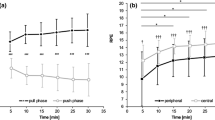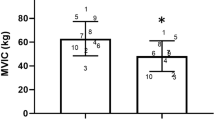Abstract
In occupational work, continuous repetitive and isometric actions performed with the upper extremity primarily cause local muscle strain and musculoskeletal disorders. They may also have some adverse effects on the cardiorespiratory system, particularly, through the elevation of blood pressure. The aim of the present study was to compare peak cardiorespiratory responses to fatiguing dynamic and isometric hand-grip exercise. The subjects were 21 untrained healthy men aged 24–45 years. The dynamic hand-grip exercise (DHGE) was performed using the left hand-grip muscles at the 57 (SD 4)% level of each individual's maximal voluntary contraction (MVC) with a frequency of 51 (SD 4) grips · min−l. The isometric hand-grip exercise (IHGE) was done using the right hand at 46 (SD 3)% of the MVC. The endurance time, ventilatory gas exchange, heart rate (HR) and blood pressure were mea- sured during both kinds of exercise. The mean endurance times for DHGE and IHGE were different, 170 (SD 62) and 99 (SD 27) s, respectively (P < 0.001). During DHGE the mean peak values of the breathing frequency [20 (SD 6) breaths · min−1] and tidal volume [0.89 (SD 0.34) l] differed significantly (P < 0.01) from peak values obtained during IHGE [15 (SD 5) breaths · min−1, and 1.14 (SD 0.32) l, respectively]. The corresponding peak oxygen consumptions, pulmonary ventilations, HR and systolic blood pressures did not differ, and were 0.51 (SD 0.06) and 0.46 (SD 0.11) l · min−1, 17.1 (SD 3.0) and 16.7 (SD 4.7) l · min−1, 103 (SD 18) and 102 (SD 17) beats · min−1, and 156 (SD 17) and 161 (SD 17) mmHg, respectively. The endurance times of both DHGE and IHGE were short (<240 s). The results indicate that the peak responses for the ventilatory gas exchange, HR and blood pressure were similar during fatiguing DHGE and IHGE, whereas the breathing patterns differed significantly between the two types of exercise. The present findings emphasize the importance of following ergonomic design principles in occupational settings which aim to reduce the output of force, particularly in tasks requiring isometric and/or one-sided repetitive muscle actions.
Similar content being viewed by others
Author information
Authors and Affiliations
Additional information
Accepted: 16 February 2000
Rights and permissions
About this article
Cite this article
Louhevaara, V., Smolander, J., Aminoff, T. et al. Cardiorespiratory responses to fatiguing dynamic and isometric hand-grip exercise. Eur J Appl Physiol 82, 340–344 (2000). https://doi.org/10.1007/s004210000200
Issue Date:
DOI: https://doi.org/10.1007/s004210000200




